Accounting Theory and Corporate Governance: A Comparative Study of Wesfarmers Limited and Woolworth Limited
VerifiedAdded on 2023/04/25
|14
|2924
|338
AI Summary
This study compares the corporate governance policies of Wesfarmers Limited and Woolworth Limited. It covers topics such as board composition, non-executive directors, independent directors, CEO statements, institutional shareholders, and CG principles. The study also discusses the implementation of CLERP 9 and the importance of integrated reporting in financial reporting.
Contribute Materials
Your contribution can guide someone’s learning journey. Share your
documents today.

Running head: ACCOUNTING THEORY AND CORPORATE GOVERNANCE
Accounting Theory and Corporate Governance
Name of the Student
Name of the University
Author’s Note
Table of Contents
Accounting Theory and Corporate Governance
Name of the Student
Name of the University
Author’s Note
Table of Contents
Secure Best Marks with AI Grader
Need help grading? Try our AI Grader for instant feedback on your assignments.
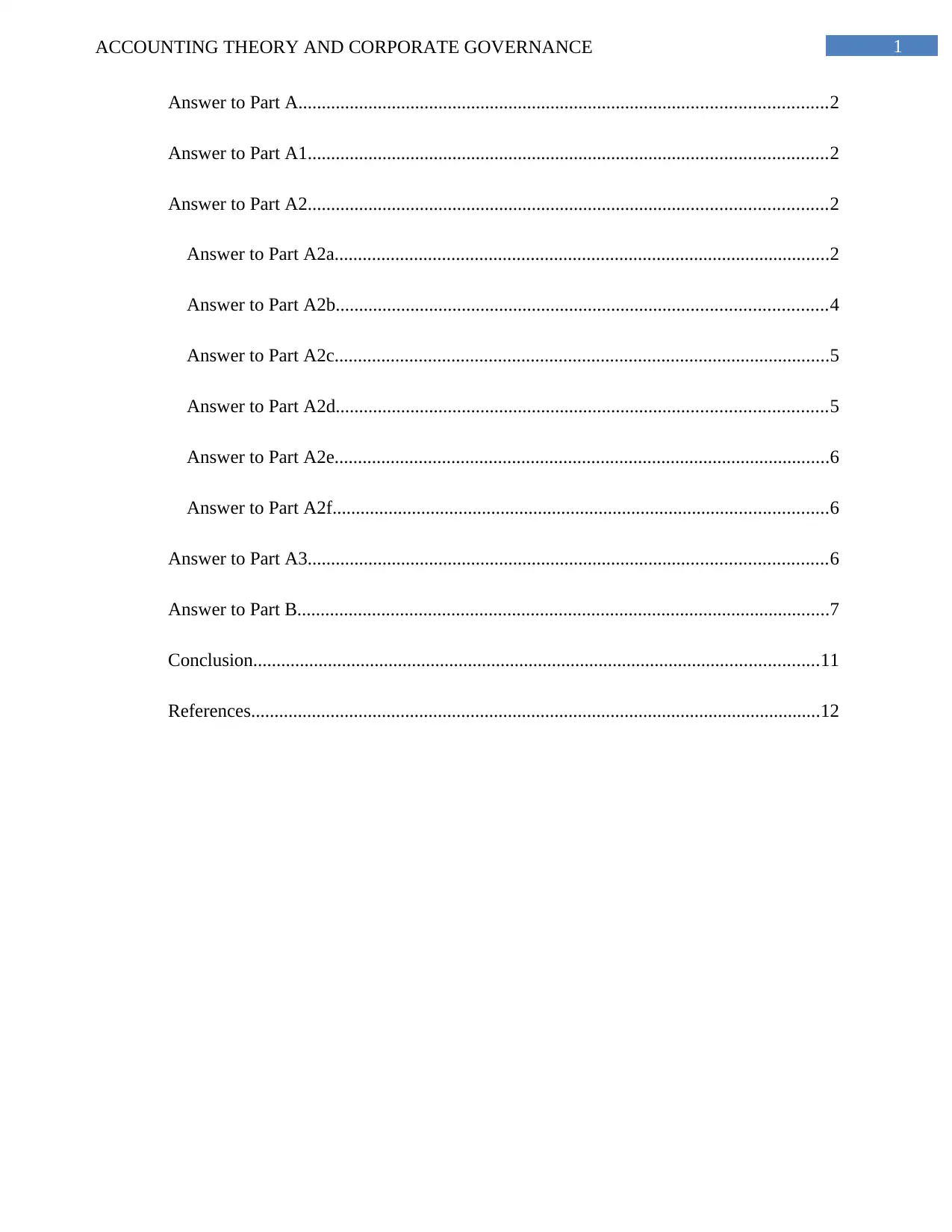
1ACCOUNTING THEORY AND CORPORATE GOVERNANCE
Answer to Part A.................................................................................................................2
Answer to Part A1...............................................................................................................2
Answer to Part A2...............................................................................................................2
Answer to Part A2a..........................................................................................................2
Answer to Part A2b.........................................................................................................4
Answer to Part A2c..........................................................................................................5
Answer to Part A2d.........................................................................................................5
Answer to Part A2e..........................................................................................................6
Answer to Part A2f..........................................................................................................6
Answer to Part A3...............................................................................................................6
Answer to Part B..................................................................................................................7
Conclusion.........................................................................................................................11
References..........................................................................................................................12
Answer to Part A.................................................................................................................2
Answer to Part A1...............................................................................................................2
Answer to Part A2...............................................................................................................2
Answer to Part A2a..........................................................................................................2
Answer to Part A2b.........................................................................................................4
Answer to Part A2c..........................................................................................................5
Answer to Part A2d.........................................................................................................5
Answer to Part A2e..........................................................................................................6
Answer to Part A2f..........................................................................................................6
Answer to Part A3...............................................................................................................6
Answer to Part B..................................................................................................................7
Conclusion.........................................................................................................................11
References..........................................................................................................................12

2ACCOUNTING THEORY AND CORPORATE GOVERNANCE
Answer to Part A
Answer to Part A1
Corporate Governance disclosure by Wesfarmers Limited
Some of the most evident policies followed by Wesfarmers Ltd. can be inferred as per
various considerations of the reporting which are identified with a blend of gender diversity,
skills, expertise including experience required decision making by the board.
Disclosure of CG by Woolworth Limited
The significant policies as per CG has been identified as per long-term shareholder value.
This includes the commitment made by the group associated towards maintaining the policies
which are of highest standard of compliance and disclosure.
Answer to Part A2
Answer to Part A2a
Directors count in Wesfarmers Limited
The board of Wesfarmers consists of 12 members. This is inclusive of directors such as
Bassat, Bowen, Howarth and Osborn.
Answer to Part A
Answer to Part A1
Corporate Governance disclosure by Wesfarmers Limited
Some of the most evident policies followed by Wesfarmers Ltd. can be inferred as per
various considerations of the reporting which are identified with a blend of gender diversity,
skills, expertise including experience required decision making by the board.
Disclosure of CG by Woolworth Limited
The significant policies as per CG has been identified as per long-term shareholder value.
This includes the commitment made by the group associated towards maintaining the policies
which are of highest standard of compliance and disclosure.
Answer to Part A2
Answer to Part A2a
Directors count in Wesfarmers Limited
The board of Wesfarmers consists of 12 members. This is inclusive of directors such as
Bassat, Bowen, Howarth and Osborn.
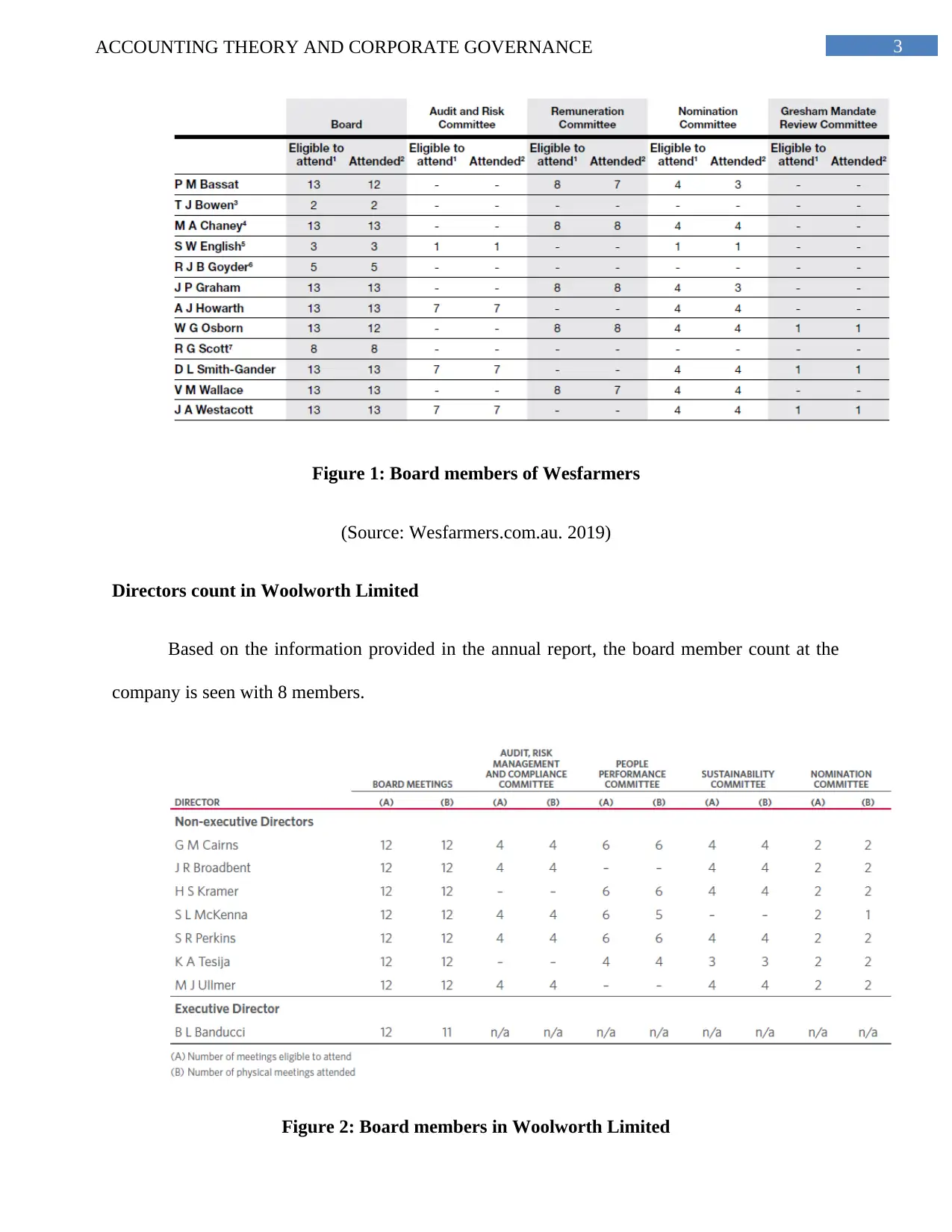
3ACCOUNTING THEORY AND CORPORATE GOVERNANCE
Figure 1: Board members of Wesfarmers
(Source: Wesfarmers.com.au. 2019)
Directors count in Woolworth Limited
Based on the information provided in the annual report, the board member count at the
company is seen with 8 members.
Figure 2: Board members in Woolworth Limited
Figure 1: Board members of Wesfarmers
(Source: Wesfarmers.com.au. 2019)
Directors count in Woolworth Limited
Based on the information provided in the annual report, the board member count at the
company is seen with 8 members.
Figure 2: Board members in Woolworth Limited
Secure Best Marks with AI Grader
Need help grading? Try our AI Grader for instant feedback on your assignments.
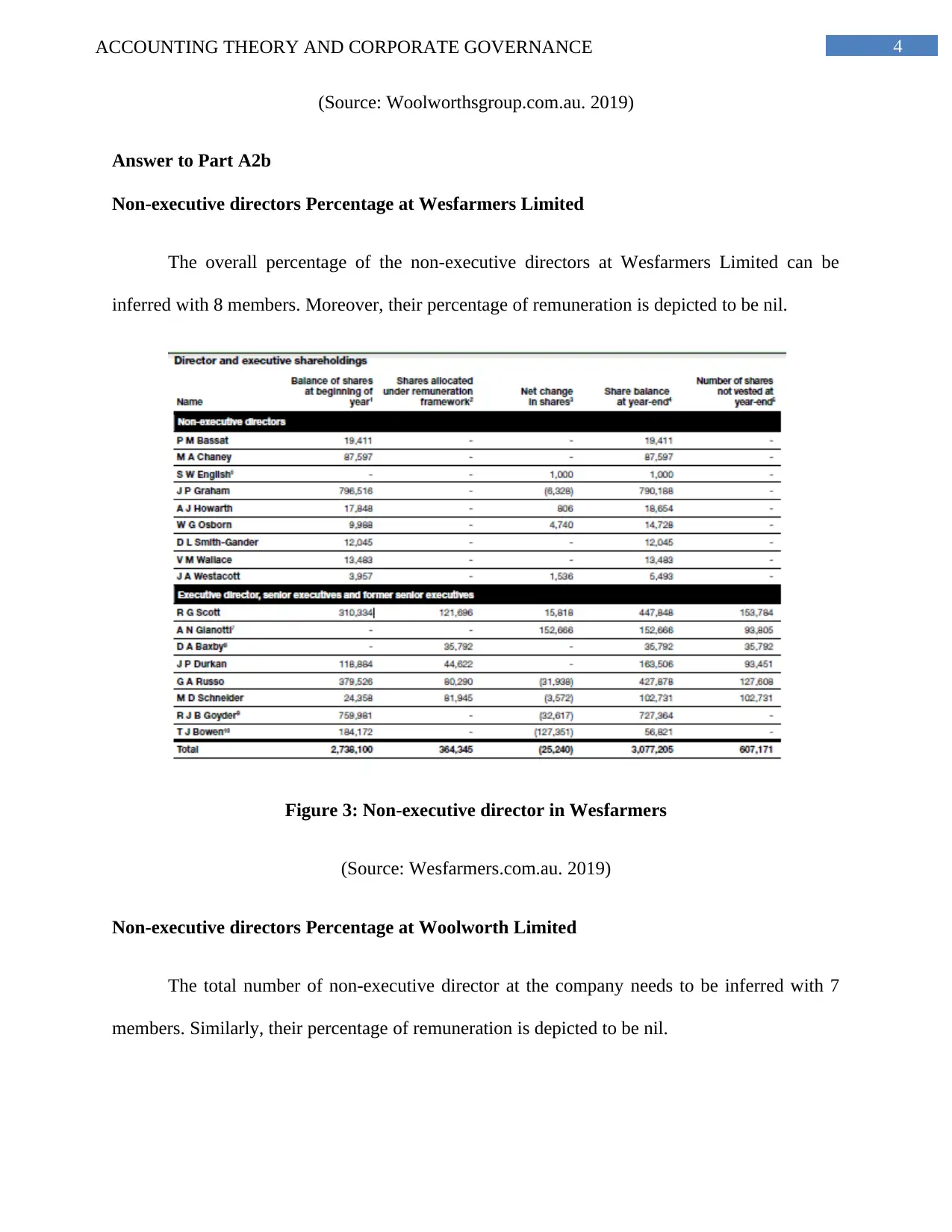
4ACCOUNTING THEORY AND CORPORATE GOVERNANCE
(Source: Woolworthsgroup.com.au. 2019)
Answer to Part A2b
Non-executive directors Percentage at Wesfarmers Limited
The overall percentage of the non-executive directors at Wesfarmers Limited can be
inferred with 8 members. Moreover, their percentage of remuneration is depicted to be nil.
Figure 3: Non-executive director in Wesfarmers
(Source: Wesfarmers.com.au. 2019)
Non-executive directors Percentage at Woolworth Limited
The total number of non-executive director at the company needs to be inferred with 7
members. Similarly, their percentage of remuneration is depicted to be nil.
(Source: Woolworthsgroup.com.au. 2019)
Answer to Part A2b
Non-executive directors Percentage at Wesfarmers Limited
The overall percentage of the non-executive directors at Wesfarmers Limited can be
inferred with 8 members. Moreover, their percentage of remuneration is depicted to be nil.
Figure 3: Non-executive director in Wesfarmers
(Source: Wesfarmers.com.au. 2019)
Non-executive directors Percentage at Woolworth Limited
The total number of non-executive director at the company needs to be inferred with 7
members. Similarly, their percentage of remuneration is depicted to be nil.
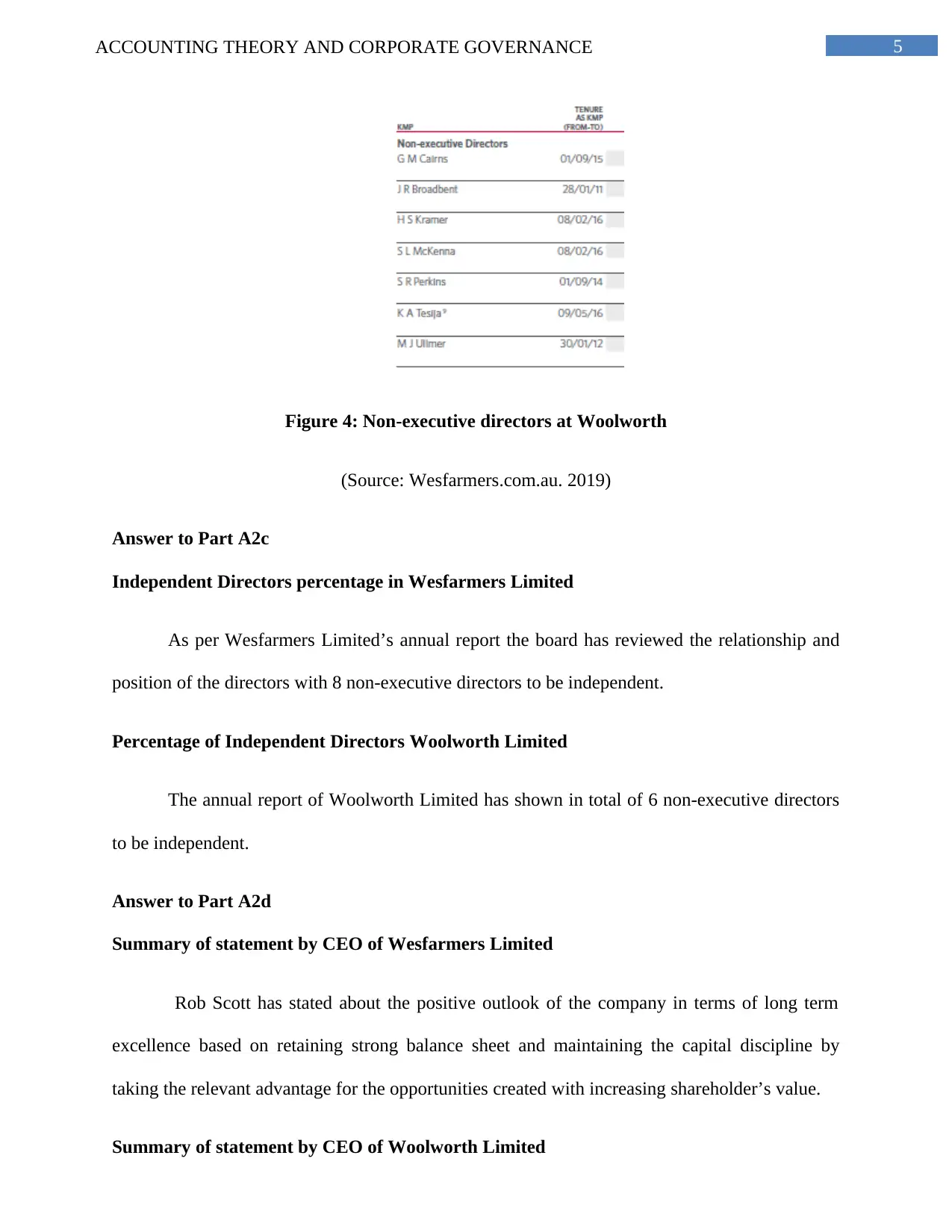
5ACCOUNTING THEORY AND CORPORATE GOVERNANCE
Figure 4: Non-executive directors at Woolworth
(Source: Wesfarmers.com.au. 2019)
Answer to Part A2c
Independent Directors percentage in Wesfarmers Limited
As per Wesfarmers Limited’s annual report the board has reviewed the relationship and
position of the directors with 8 non-executive directors to be independent.
Percentage of Independent Directors Woolworth Limited
The annual report of Woolworth Limited has shown in total of 6 non-executive directors
to be independent.
Answer to Part A2d
Summary of statement by CEO of Wesfarmers Limited
Rob Scott has stated about the positive outlook of the company in terms of long term
excellence based on retaining strong balance sheet and maintaining the capital discipline by
taking the relevant advantage for the opportunities created with increasing shareholder’s value.
Summary of statement by CEO of Woolworth Limited
Figure 4: Non-executive directors at Woolworth
(Source: Wesfarmers.com.au. 2019)
Answer to Part A2c
Independent Directors percentage in Wesfarmers Limited
As per Wesfarmers Limited’s annual report the board has reviewed the relationship and
position of the directors with 8 non-executive directors to be independent.
Percentage of Independent Directors Woolworth Limited
The annual report of Woolworth Limited has shown in total of 6 non-executive directors
to be independent.
Answer to Part A2d
Summary of statement by CEO of Wesfarmers Limited
Rob Scott has stated about the positive outlook of the company in terms of long term
excellence based on retaining strong balance sheet and maintaining the capital discipline by
taking the relevant advantage for the opportunities created with increasing shareholder’s value.
Summary of statement by CEO of Woolworth Limited

6ACCOUNTING THEORY AND CORPORATE GOVERNANCE
CEO Brad Banducci has depicted creating improved experiences by the company in
terms of fulfilling the needs of customers for transforming the food business division in NZ and
Australia.
Answer to Part A2e
It can be identified that the non-executive directors do not hold any shares in either
companies.
Answer to Part A2f
Institutional Shareholders of Wesfarmers
The largest shareholders of the company can be inferred with J.P. Morgan Nominees
Australia Limited holding with 15.15% issued share capital, HSBC Custody Nominees
(Australia) Limited 23% of issued share capital and 5.31%. by Citicorp Nominees Pty Limited.
Institutional Shareholders of Woolworth
HSBC Custody Nominees (Australia) Limited can be depicted as the largest shareholder
of the company with issued share of 24.16%, J.P. Morgan Nominees Australia Limited has been
further considers a significant shareholder with 15.10% of issued share. The BNP Paribas
Nominees Pty limited is seen with 6.76% of the shareholding and Citicorp Nominees Pty
Limited with 5.64%.
Answer to Part A3
CG principles comparison is listed as follows:
Basis of comparison Wesfarmers Ltd Woolworth ltd.
Effectiveness The effectiveness is identified
with considering disclosure on
The elaborated summary may be
effective in terms of the
CEO Brad Banducci has depicted creating improved experiences by the company in
terms of fulfilling the needs of customers for transforming the food business division in NZ and
Australia.
Answer to Part A2e
It can be identified that the non-executive directors do not hold any shares in either
companies.
Answer to Part A2f
Institutional Shareholders of Wesfarmers
The largest shareholders of the company can be inferred with J.P. Morgan Nominees
Australia Limited holding with 15.15% issued share capital, HSBC Custody Nominees
(Australia) Limited 23% of issued share capital and 5.31%. by Citicorp Nominees Pty Limited.
Institutional Shareholders of Woolworth
HSBC Custody Nominees (Australia) Limited can be depicted as the largest shareholder
of the company with issued share of 24.16%, J.P. Morgan Nominees Australia Limited has been
further considers a significant shareholder with 15.10% of issued share. The BNP Paribas
Nominees Pty limited is seen with 6.76% of the shareholding and Citicorp Nominees Pty
Limited with 5.64%.
Answer to Part A3
CG principles comparison is listed as follows:
Basis of comparison Wesfarmers Ltd Woolworth ltd.
Effectiveness The effectiveness is identified
with considering disclosure on
The elaborated summary may be
effective in terms of the
Paraphrase This Document
Need a fresh take? Get an instant paraphrase of this document with our AI Paraphraser
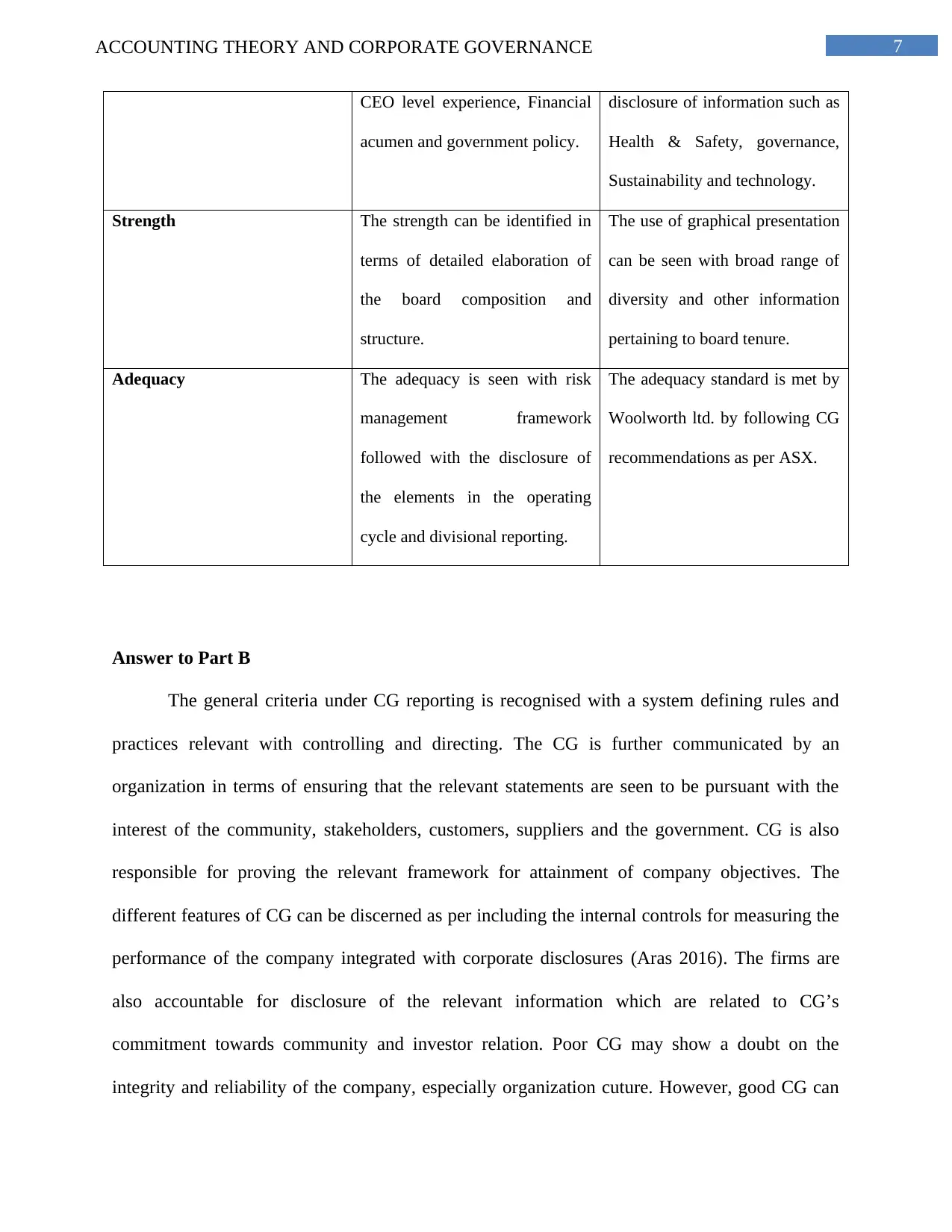
7ACCOUNTING THEORY AND CORPORATE GOVERNANCE
CEO level experience, Financial
acumen and government policy.
disclosure of information such as
Health & Safety, governance,
Sustainability and technology.
Strength The strength can be identified in
terms of detailed elaboration of
the board composition and
structure.
The use of graphical presentation
can be seen with broad range of
diversity and other information
pertaining to board tenure.
Adequacy The adequacy is seen with risk
management framework
followed with the disclosure of
the elements in the operating
cycle and divisional reporting.
The adequacy standard is met by
Woolworth ltd. by following CG
recommendations as per ASX.
Answer to Part B
The general criteria under CG reporting is recognised with a system defining rules and
practices relevant with controlling and directing. The CG is further communicated by an
organization in terms of ensuring that the relevant statements are seen to be pursuant with the
interest of the community, stakeholders, customers, suppliers and the government. CG is also
responsible for proving the relevant framework for attainment of company objectives. The
different features of CG can be discerned as per including the internal controls for measuring the
performance of the company integrated with corporate disclosures (Aras 2016). The firms are
also accountable for disclosure of the relevant information which are related to CG’s
commitment towards community and investor relation. Poor CG may show a doubt on the
integrity and reliability of the company, especially organization cuture. However, good CG can
CEO level experience, Financial
acumen and government policy.
disclosure of information such as
Health & Safety, governance,
Sustainability and technology.
Strength The strength can be identified in
terms of detailed elaboration of
the board composition and
structure.
The use of graphical presentation
can be seen with broad range of
diversity and other information
pertaining to board tenure.
Adequacy The adequacy is seen with risk
management framework
followed with the disclosure of
the elements in the operating
cycle and divisional reporting.
The adequacy standard is met by
Woolworth ltd. by following CG
recommendations as per ASX.
Answer to Part B
The general criteria under CG reporting is recognised with a system defining rules and
practices relevant with controlling and directing. The CG is further communicated by an
organization in terms of ensuring that the relevant statements are seen to be pursuant with the
interest of the community, stakeholders, customers, suppliers and the government. CG is also
responsible for proving the relevant framework for attainment of company objectives. The
different features of CG can be discerned as per including the internal controls for measuring the
performance of the company integrated with corporate disclosures (Aras 2016). The firms are
also accountable for disclosure of the relevant information which are related to CG’s
commitment towards community and investor relation. Poor CG may show a doubt on the
integrity and reliability of the company, especially organization cuture. However, good CG can
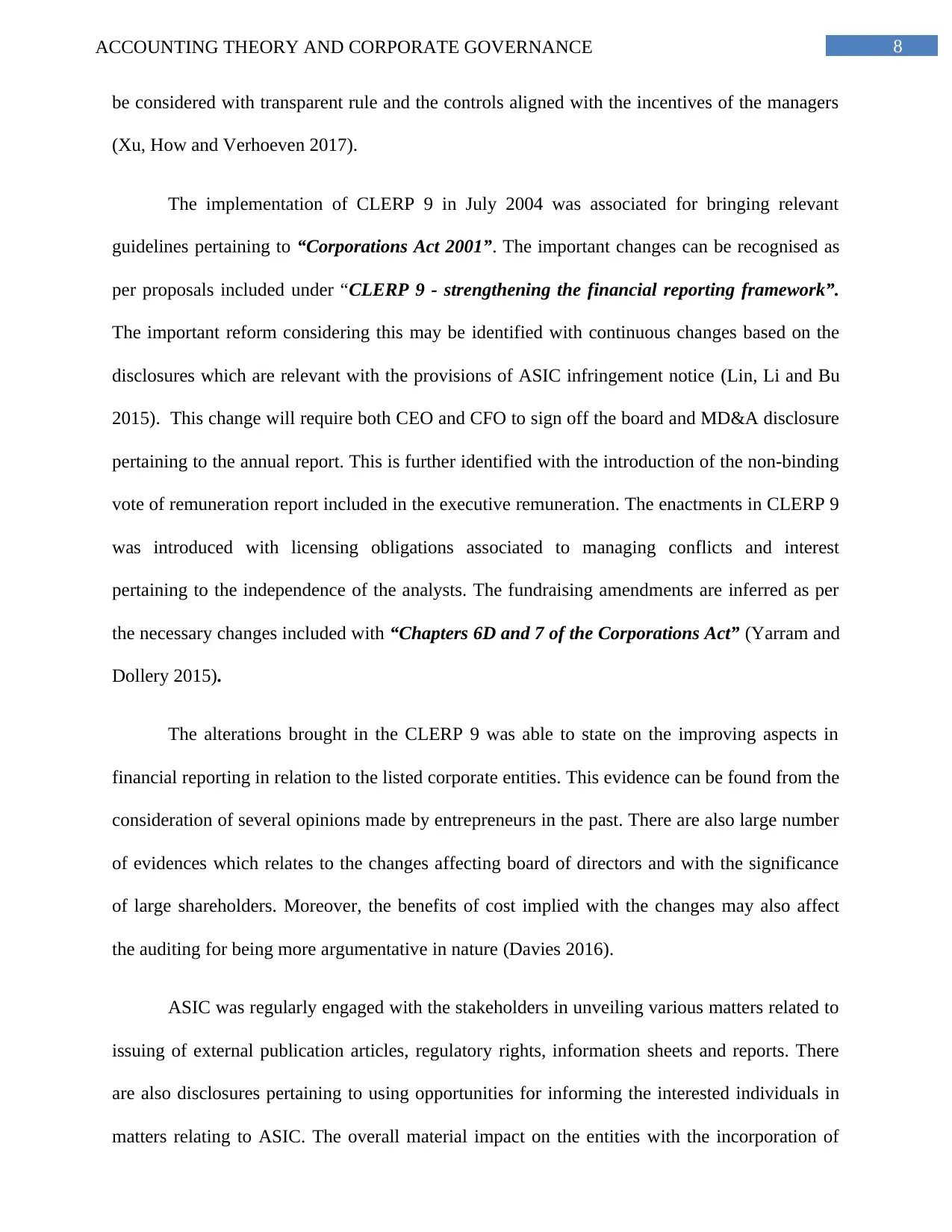
8ACCOUNTING THEORY AND CORPORATE GOVERNANCE
be considered with transparent rule and the controls aligned with the incentives of the managers
(Xu, How and Verhoeven 2017).
The implementation of CLERP 9 in July 2004 was associated for bringing relevant
guidelines pertaining to “Corporations Act 2001”. The important changes can be recognised as
per proposals included under “CLERP 9 - strengthening the financial reporting framework”.
The important reform considering this may be identified with continuous changes based on the
disclosures which are relevant with the provisions of ASIC infringement notice (Lin, Li and Bu
2015). This change will require both CEO and CFO to sign off the board and MD&A disclosure
pertaining to the annual report. This is further identified with the introduction of the non-binding
vote of remuneration report included in the executive remuneration. The enactments in CLERP 9
was introduced with licensing obligations associated to managing conflicts and interest
pertaining to the independence of the analysts. The fundraising amendments are inferred as per
the necessary changes included with “Chapters 6D and 7 of the Corporations Act” (Yarram and
Dollery 2015).
The alterations brought in the CLERP 9 was able to state on the improving aspects in
financial reporting in relation to the listed corporate entities. This evidence can be found from the
consideration of several opinions made by entrepreneurs in the past. There are also large number
of evidences which relates to the changes affecting board of directors and with the significance
of large shareholders. Moreover, the benefits of cost implied with the changes may also affect
the auditing for being more argumentative in nature (Davies 2016).
ASIC was regularly engaged with the stakeholders in unveiling various matters related to
issuing of external publication articles, regulatory rights, information sheets and reports. There
are also disclosures pertaining to using opportunities for informing the interested individuals in
matters relating to ASIC. The overall material impact on the entities with the incorporation of
be considered with transparent rule and the controls aligned with the incentives of the managers
(Xu, How and Verhoeven 2017).
The implementation of CLERP 9 in July 2004 was associated for bringing relevant
guidelines pertaining to “Corporations Act 2001”. The important changes can be recognised as
per proposals included under “CLERP 9 - strengthening the financial reporting framework”.
The important reform considering this may be identified with continuous changes based on the
disclosures which are relevant with the provisions of ASIC infringement notice (Lin, Li and Bu
2015). This change will require both CEO and CFO to sign off the board and MD&A disclosure
pertaining to the annual report. This is further identified with the introduction of the non-binding
vote of remuneration report included in the executive remuneration. The enactments in CLERP 9
was introduced with licensing obligations associated to managing conflicts and interest
pertaining to the independence of the analysts. The fundraising amendments are inferred as per
the necessary changes included with “Chapters 6D and 7 of the Corporations Act” (Yarram and
Dollery 2015).
The alterations brought in the CLERP 9 was able to state on the improving aspects in
financial reporting in relation to the listed corporate entities. This evidence can be found from the
consideration of several opinions made by entrepreneurs in the past. There are also large number
of evidences which relates to the changes affecting board of directors and with the significance
of large shareholders. Moreover, the benefits of cost implied with the changes may also affect
the auditing for being more argumentative in nature (Davies 2016).
ASIC was regularly engaged with the stakeholders in unveiling various matters related to
issuing of external publication articles, regulatory rights, information sheets and reports. There
are also disclosures pertaining to using opportunities for informing the interested individuals in
matters relating to ASIC. The overall material impact on the entities with the incorporation of
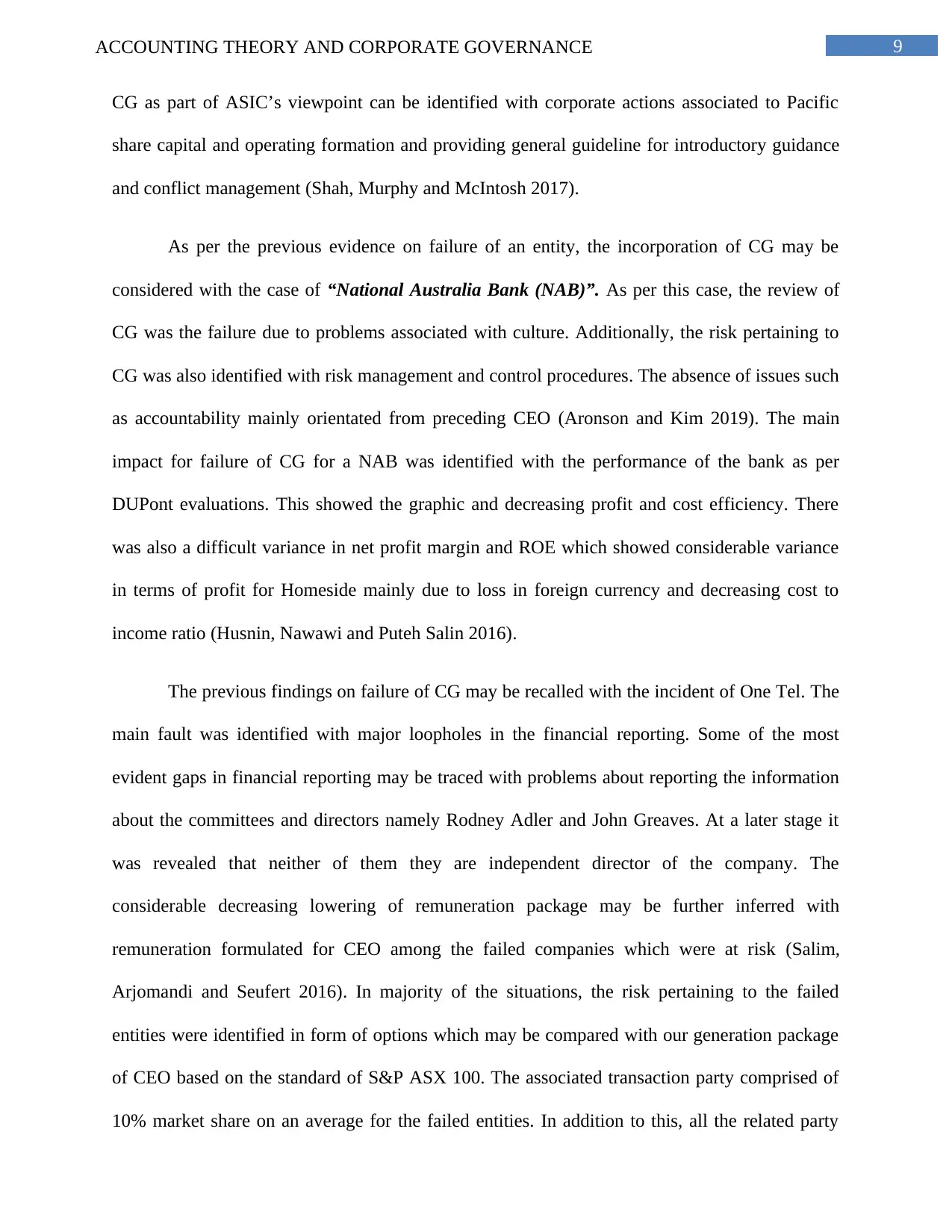
9ACCOUNTING THEORY AND CORPORATE GOVERNANCE
CG as part of ASIC’s viewpoint can be identified with corporate actions associated to Pacific
share capital and operating formation and providing general guideline for introductory guidance
and conflict management (Shah, Murphy and McIntosh 2017).
As per the previous evidence on failure of an entity, the incorporation of CG may be
considered with the case of “National Australia Bank (NAB)”. As per this case, the review of
CG was the failure due to problems associated with culture. Additionally, the risk pertaining to
CG was also identified with risk management and control procedures. The absence of issues such
as accountability mainly orientated from preceding CEO (Aronson and Kim 2019). The main
impact for failure of CG for a NAB was identified with the performance of the bank as per
DUPont evaluations. This showed the graphic and decreasing profit and cost efficiency. There
was also a difficult variance in net profit margin and ROE which showed considerable variance
in terms of profit for Homeside mainly due to loss in foreign currency and decreasing cost to
income ratio (Husnin, Nawawi and Puteh Salin 2016).
The previous findings on failure of CG may be recalled with the incident of One Tel. The
main fault was identified with major loopholes in the financial reporting. Some of the most
evident gaps in financial reporting may be traced with problems about reporting the information
about the committees and directors namely Rodney Adler and John Greaves. At a later stage it
was revealed that neither of them they are independent director of the company. The
considerable decreasing lowering of remuneration package may be further inferred with
remuneration formulated for CEO among the failed companies which were at risk (Salim,
Arjomandi and Seufert 2016). In majority of the situations, the risk pertaining to the failed
entities were identified in form of options which may be compared with our generation package
of CEO based on the standard of S&P ASX 100. The associated transaction party comprised of
10% market share on an average for the failed entities. In addition to this, all the related party
CG as part of ASIC’s viewpoint can be identified with corporate actions associated to Pacific
share capital and operating formation and providing general guideline for introductory guidance
and conflict management (Shah, Murphy and McIntosh 2017).
As per the previous evidence on failure of an entity, the incorporation of CG may be
considered with the case of “National Australia Bank (NAB)”. As per this case, the review of
CG was the failure due to problems associated with culture. Additionally, the risk pertaining to
CG was also identified with risk management and control procedures. The absence of issues such
as accountability mainly orientated from preceding CEO (Aronson and Kim 2019). The main
impact for failure of CG for a NAB was identified with the performance of the bank as per
DUPont evaluations. This showed the graphic and decreasing profit and cost efficiency. There
was also a difficult variance in net profit margin and ROE which showed considerable variance
in terms of profit for Homeside mainly due to loss in foreign currency and decreasing cost to
income ratio (Husnin, Nawawi and Puteh Salin 2016).
The previous findings on failure of CG may be recalled with the incident of One Tel. The
main fault was identified with major loopholes in the financial reporting. Some of the most
evident gaps in financial reporting may be traced with problems about reporting the information
about the committees and directors namely Rodney Adler and John Greaves. At a later stage it
was revealed that neither of them they are independent director of the company. The
considerable decreasing lowering of remuneration package may be further inferred with
remuneration formulated for CEO among the failed companies which were at risk (Salim,
Arjomandi and Seufert 2016). In majority of the situations, the risk pertaining to the failed
entities were identified in form of options which may be compared with our generation package
of CEO based on the standard of S&P ASX 100. The associated transaction party comprised of
10% market share on an average for the failed entities. In addition to this, all the related party
Secure Best Marks with AI Grader
Need help grading? Try our AI Grader for instant feedback on your assignments.
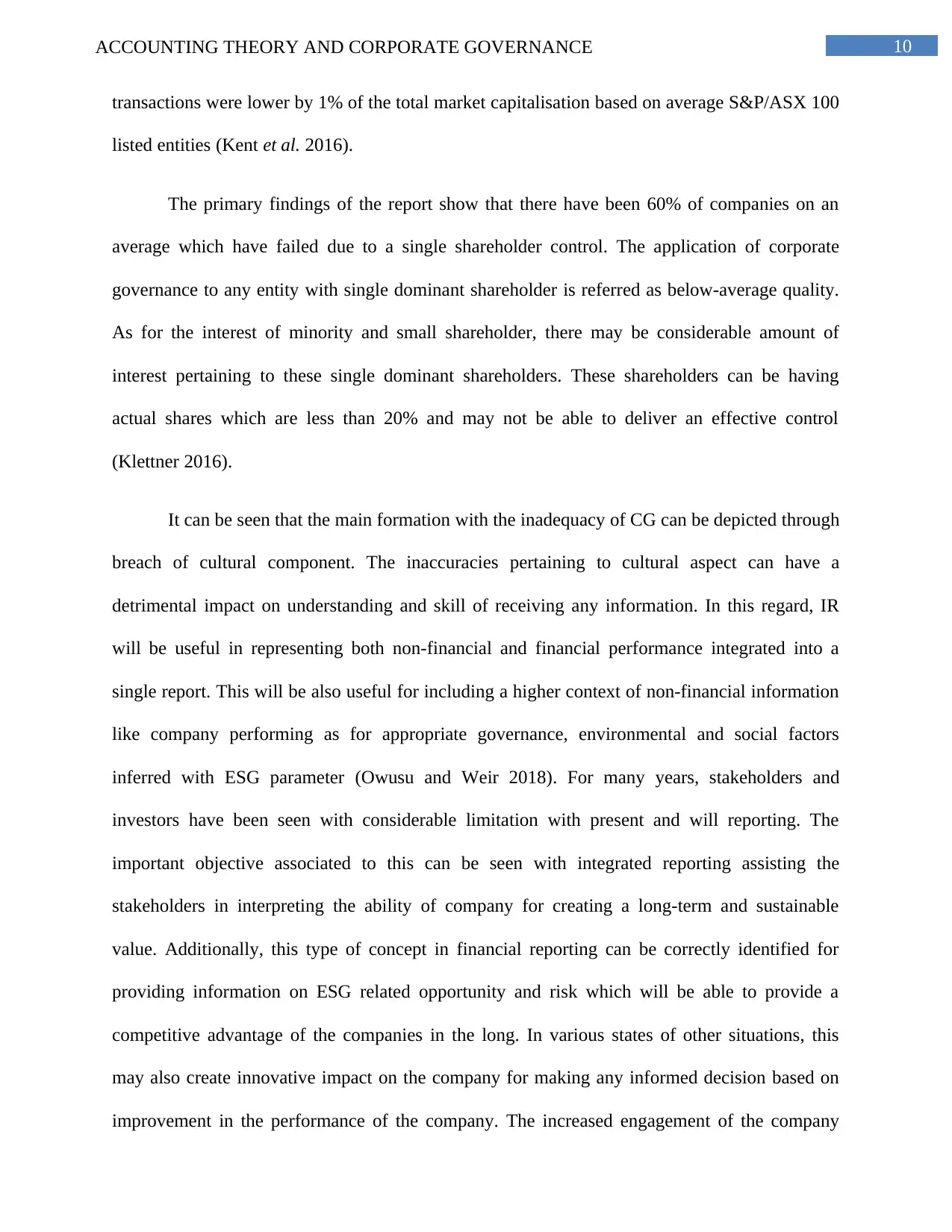
10ACCOUNTING THEORY AND CORPORATE GOVERNANCE
transactions were lower by 1% of the total market capitalisation based on average S&P/ASX 100
listed entities (Kent et al. 2016).
The primary findings of the report show that there have been 60% of companies on an
average which have failed due to a single shareholder control. The application of corporate
governance to any entity with single dominant shareholder is referred as below-average quality.
As for the interest of minority and small shareholder, there may be considerable amount of
interest pertaining to these single dominant shareholders. These shareholders can be having
actual shares which are less than 20% and may not be able to deliver an effective control
(Klettner 2016).
It can be seen that the main formation with the inadequacy of CG can be depicted through
breach of cultural component. The inaccuracies pertaining to cultural aspect can have a
detrimental impact on understanding and skill of receiving any information. In this regard, IR
will be useful in representing both non-financial and financial performance integrated into a
single report. This will be also useful for including a higher context of non-financial information
like company performing as for appropriate governance, environmental and social factors
inferred with ESG parameter (Owusu and Weir 2018). For many years, stakeholders and
investors have been seen with considerable limitation with present and will reporting. The
important objective associated to this can be seen with integrated reporting assisting the
stakeholders in interpreting the ability of company for creating a long-term and sustainable
value. Additionally, this type of concept in financial reporting can be correctly identified for
providing information on ESG related opportunity and risk which will be able to provide a
competitive advantage of the companies in the long. In various states of other situations, this
may also create innovative impact on the company for making any informed decision based on
improvement in the performance of the company. The increased engagement of the company
transactions were lower by 1% of the total market capitalisation based on average S&P/ASX 100
listed entities (Kent et al. 2016).
The primary findings of the report show that there have been 60% of companies on an
average which have failed due to a single shareholder control. The application of corporate
governance to any entity with single dominant shareholder is referred as below-average quality.
As for the interest of minority and small shareholder, there may be considerable amount of
interest pertaining to these single dominant shareholders. These shareholders can be having
actual shares which are less than 20% and may not be able to deliver an effective control
(Klettner 2016).
It can be seen that the main formation with the inadequacy of CG can be depicted through
breach of cultural component. The inaccuracies pertaining to cultural aspect can have a
detrimental impact on understanding and skill of receiving any information. In this regard, IR
will be useful in representing both non-financial and financial performance integrated into a
single report. This will be also useful for including a higher context of non-financial information
like company performing as for appropriate governance, environmental and social factors
inferred with ESG parameter (Owusu and Weir 2018). For many years, stakeholders and
investors have been seen with considerable limitation with present and will reporting. The
important objective associated to this can be seen with integrated reporting assisting the
stakeholders in interpreting the ability of company for creating a long-term and sustainable
value. Additionally, this type of concept in financial reporting can be correctly identified for
providing information on ESG related opportunity and risk which will be able to provide a
competitive advantage of the companies in the long. In various states of other situations, this
may also create innovative impact on the company for making any informed decision based on
improvement in the performance of the company. The increased engagement of the company
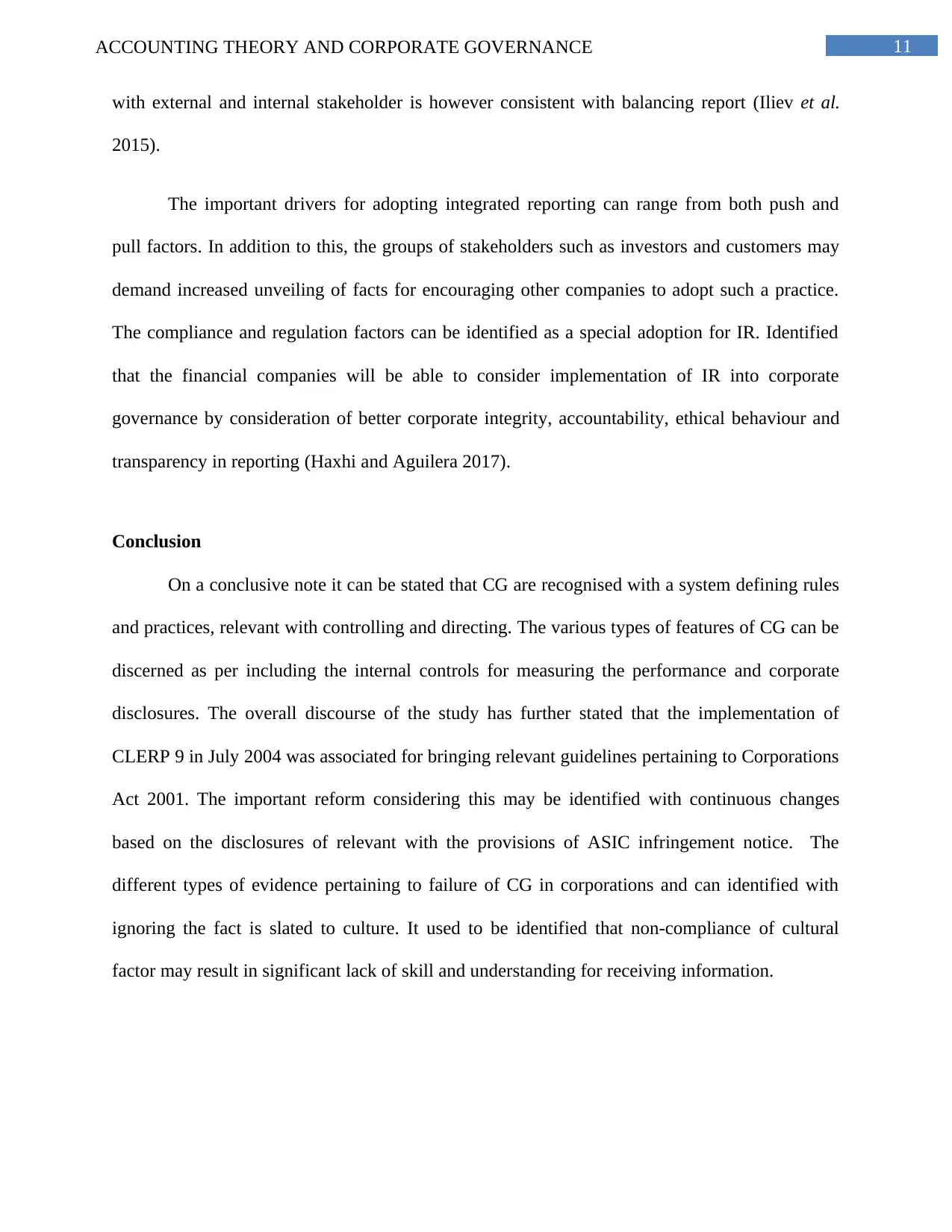
11ACCOUNTING THEORY AND CORPORATE GOVERNANCE
with external and internal stakeholder is however consistent with balancing report (Iliev et al.
2015).
The important drivers for adopting integrated reporting can range from both push and
pull factors. In addition to this, the groups of stakeholders such as investors and customers may
demand increased unveiling of facts for encouraging other companies to adopt such a practice.
The compliance and regulation factors can be identified as a special adoption for IR. Identified
that the financial companies will be able to consider implementation of IR into corporate
governance by consideration of better corporate integrity, accountability, ethical behaviour and
transparency in reporting (Haxhi and Aguilera 2017).
Conclusion
On a conclusive note it can be stated that CG are recognised with a system defining rules
and practices, relevant with controlling and directing. The various types of features of CG can be
discerned as per including the internal controls for measuring the performance and corporate
disclosures. The overall discourse of the study has further stated that the implementation of
CLERP 9 in July 2004 was associated for bringing relevant guidelines pertaining to Corporations
Act 2001. The important reform considering this may be identified with continuous changes
based on the disclosures of relevant with the provisions of ASIC infringement notice. The
different types of evidence pertaining to failure of CG in corporations and can identified with
ignoring the fact is slated to culture. It used to be identified that non-compliance of cultural
factor may result in significant lack of skill and understanding for receiving information.
with external and internal stakeholder is however consistent with balancing report (Iliev et al.
2015).
The important drivers for adopting integrated reporting can range from both push and
pull factors. In addition to this, the groups of stakeholders such as investors and customers may
demand increased unveiling of facts for encouraging other companies to adopt such a practice.
The compliance and regulation factors can be identified as a special adoption for IR. Identified
that the financial companies will be able to consider implementation of IR into corporate
governance by consideration of better corporate integrity, accountability, ethical behaviour and
transparency in reporting (Haxhi and Aguilera 2017).
Conclusion
On a conclusive note it can be stated that CG are recognised with a system defining rules
and practices, relevant with controlling and directing. The various types of features of CG can be
discerned as per including the internal controls for measuring the performance and corporate
disclosures. The overall discourse of the study has further stated that the implementation of
CLERP 9 in July 2004 was associated for bringing relevant guidelines pertaining to Corporations
Act 2001. The important reform considering this may be identified with continuous changes
based on the disclosures of relevant with the provisions of ASIC infringement notice. The
different types of evidence pertaining to failure of CG in corporations and can identified with
ignoring the fact is slated to culture. It used to be identified that non-compliance of cultural
factor may result in significant lack of skill and understanding for receiving information.
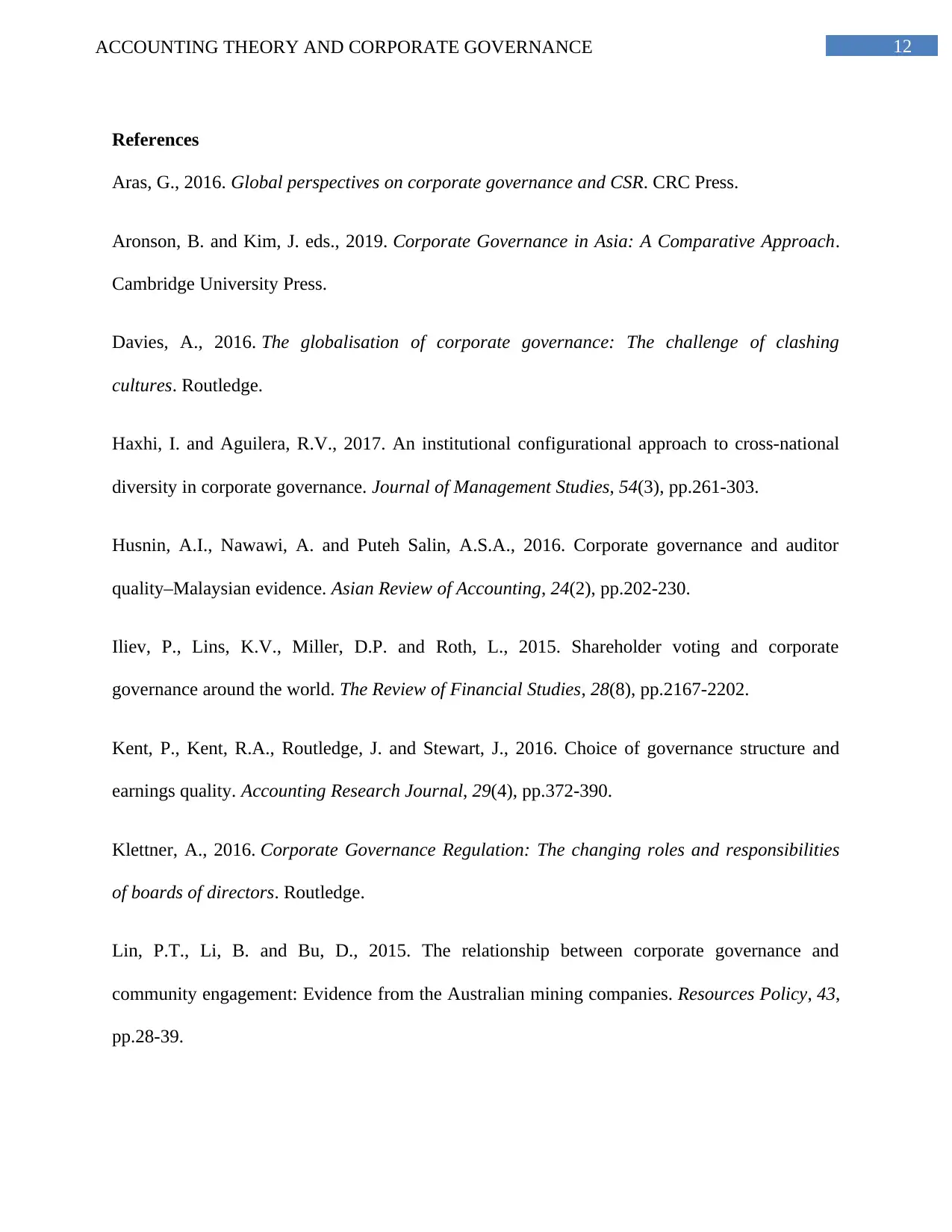
12ACCOUNTING THEORY AND CORPORATE GOVERNANCE
References
Aras, G., 2016. Global perspectives on corporate governance and CSR. CRC Press.
Aronson, B. and Kim, J. eds., 2019. Corporate Governance in Asia: A Comparative Approach.
Cambridge University Press.
Davies, A., 2016. The globalisation of corporate governance: The challenge of clashing
cultures. Routledge.
Haxhi, I. and Aguilera, R.V., 2017. An institutional configurational approach to cross‐national
diversity in corporate governance. Journal of Management Studies, 54(3), pp.261-303.
Husnin, A.I., Nawawi, A. and Puteh Salin, A.S.A., 2016. Corporate governance and auditor
quality–Malaysian evidence. Asian Review of Accounting, 24(2), pp.202-230.
Iliev, P., Lins, K.V., Miller, D.P. and Roth, L., 2015. Shareholder voting and corporate
governance around the world. The Review of Financial Studies, 28(8), pp.2167-2202.
Kent, P., Kent, R.A., Routledge, J. and Stewart, J., 2016. Choice of governance structure and
earnings quality. Accounting Research Journal, 29(4), pp.372-390.
Klettner, A., 2016. Corporate Governance Regulation: The changing roles and responsibilities
of boards of directors. Routledge.
Lin, P.T., Li, B. and Bu, D., 2015. The relationship between corporate governance and
community engagement: Evidence from the Australian mining companies. Resources Policy, 43,
pp.28-39.
References
Aras, G., 2016. Global perspectives on corporate governance and CSR. CRC Press.
Aronson, B. and Kim, J. eds., 2019. Corporate Governance in Asia: A Comparative Approach.
Cambridge University Press.
Davies, A., 2016. The globalisation of corporate governance: The challenge of clashing
cultures. Routledge.
Haxhi, I. and Aguilera, R.V., 2017. An institutional configurational approach to cross‐national
diversity in corporate governance. Journal of Management Studies, 54(3), pp.261-303.
Husnin, A.I., Nawawi, A. and Puteh Salin, A.S.A., 2016. Corporate governance and auditor
quality–Malaysian evidence. Asian Review of Accounting, 24(2), pp.202-230.
Iliev, P., Lins, K.V., Miller, D.P. and Roth, L., 2015. Shareholder voting and corporate
governance around the world. The Review of Financial Studies, 28(8), pp.2167-2202.
Kent, P., Kent, R.A., Routledge, J. and Stewart, J., 2016. Choice of governance structure and
earnings quality. Accounting Research Journal, 29(4), pp.372-390.
Klettner, A., 2016. Corporate Governance Regulation: The changing roles and responsibilities
of boards of directors. Routledge.
Lin, P.T., Li, B. and Bu, D., 2015. The relationship between corporate governance and
community engagement: Evidence from the Australian mining companies. Resources Policy, 43,
pp.28-39.
Paraphrase This Document
Need a fresh take? Get an instant paraphrase of this document with our AI Paraphraser
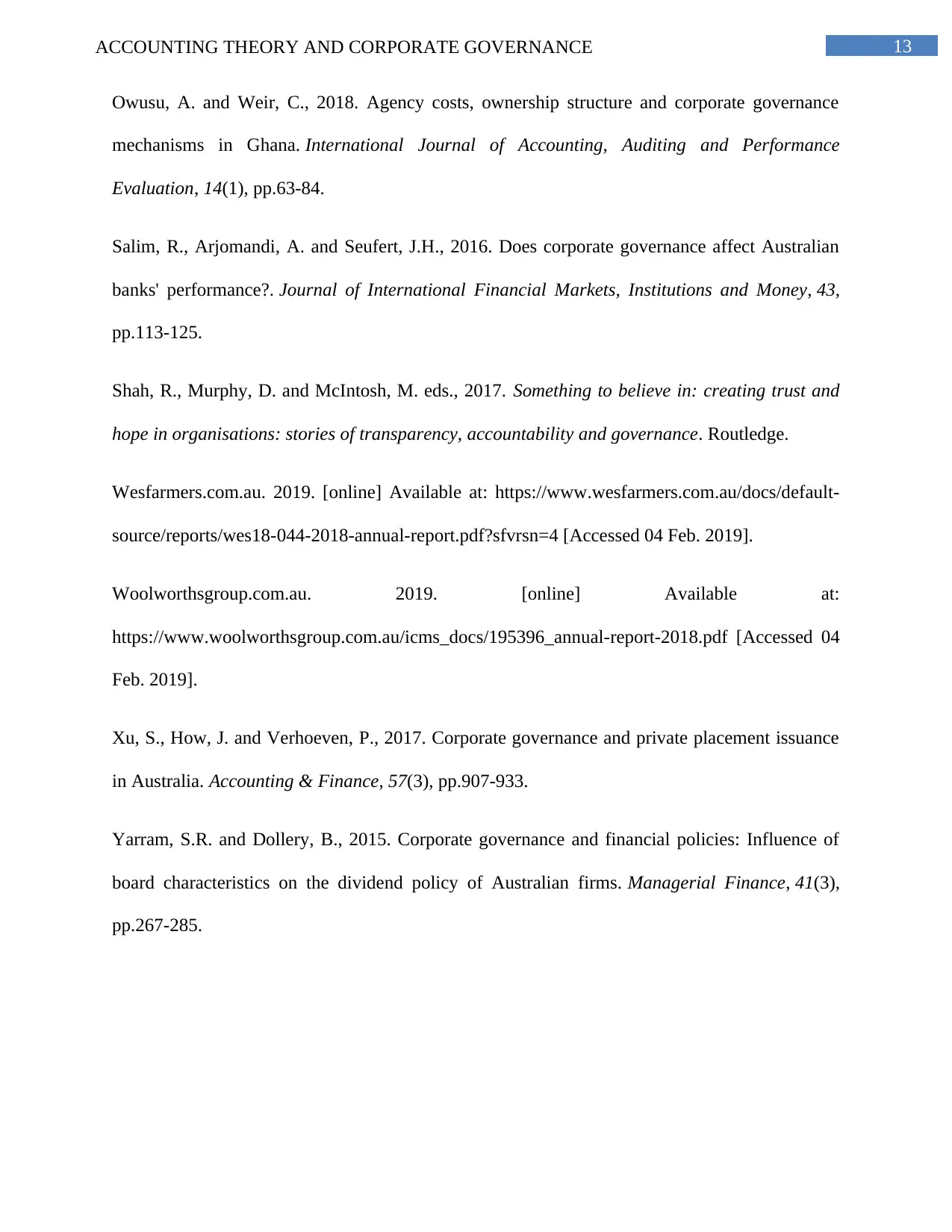
13ACCOUNTING THEORY AND CORPORATE GOVERNANCE
Owusu, A. and Weir, C., 2018. Agency costs, ownership structure and corporate governance
mechanisms in Ghana. International Journal of Accounting, Auditing and Performance
Evaluation, 14(1), pp.63-84.
Salim, R., Arjomandi, A. and Seufert, J.H., 2016. Does corporate governance affect Australian
banks' performance?. Journal of International Financial Markets, Institutions and Money, 43,
pp.113-125.
Shah, R., Murphy, D. and McIntosh, M. eds., 2017. Something to believe in: creating trust and
hope in organisations: stories of transparency, accountability and governance. Routledge.
Wesfarmers.com.au. 2019. [online] Available at: https://www.wesfarmers.com.au/docs/default-
source/reports/wes18-044-2018-annual-report.pdf?sfvrsn=4 [Accessed 04 Feb. 2019].
Woolworthsgroup.com.au. 2019. [online] Available at:
https://www.woolworthsgroup.com.au/icms_docs/195396_annual-report-2018.pdf [Accessed 04
Feb. 2019].
Xu, S., How, J. and Verhoeven, P., 2017. Corporate governance and private placement issuance
in Australia. Accounting & Finance, 57(3), pp.907-933.
Yarram, S.R. and Dollery, B., 2015. Corporate governance and financial policies: Influence of
board characteristics on the dividend policy of Australian firms. Managerial Finance, 41(3),
pp.267-285.
Owusu, A. and Weir, C., 2018. Agency costs, ownership structure and corporate governance
mechanisms in Ghana. International Journal of Accounting, Auditing and Performance
Evaluation, 14(1), pp.63-84.
Salim, R., Arjomandi, A. and Seufert, J.H., 2016. Does corporate governance affect Australian
banks' performance?. Journal of International Financial Markets, Institutions and Money, 43,
pp.113-125.
Shah, R., Murphy, D. and McIntosh, M. eds., 2017. Something to believe in: creating trust and
hope in organisations: stories of transparency, accountability and governance. Routledge.
Wesfarmers.com.au. 2019. [online] Available at: https://www.wesfarmers.com.au/docs/default-
source/reports/wes18-044-2018-annual-report.pdf?sfvrsn=4 [Accessed 04 Feb. 2019].
Woolworthsgroup.com.au. 2019. [online] Available at:
https://www.woolworthsgroup.com.au/icms_docs/195396_annual-report-2018.pdf [Accessed 04
Feb. 2019].
Xu, S., How, J. and Verhoeven, P., 2017. Corporate governance and private placement issuance
in Australia. Accounting & Finance, 57(3), pp.907-933.
Yarram, S.R. and Dollery, B., 2015. Corporate governance and financial policies: Influence of
board characteristics on the dividend policy of Australian firms. Managerial Finance, 41(3),
pp.267-285.
1 out of 14
Related Documents
Your All-in-One AI-Powered Toolkit for Academic Success.
+13062052269
info@desklib.com
Available 24*7 on WhatsApp / Email
![[object Object]](/_next/static/media/star-bottom.7253800d.svg)
Unlock your academic potential
© 2024 | Zucol Services PVT LTD | All rights reserved.





